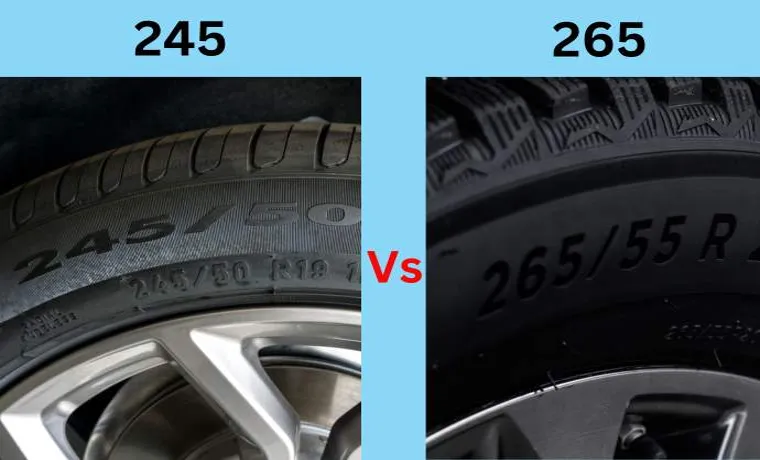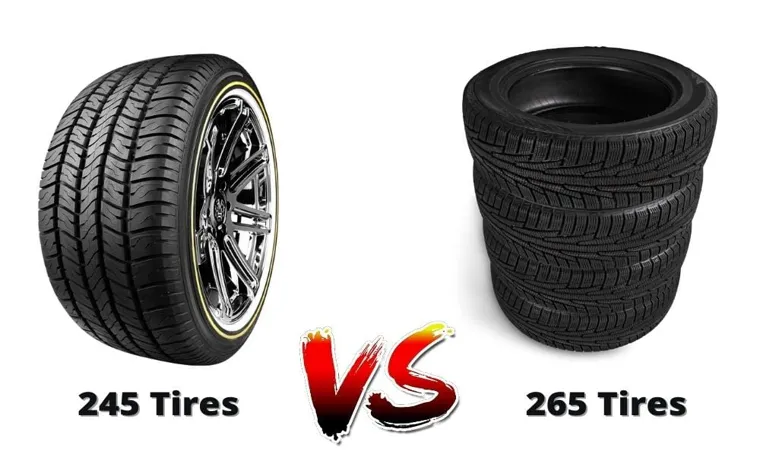Choosing the right sized tire for your vehicle can be tricky, especially if you’re not familiar with the terminology. One common question that arises when selecting tires is, “Which tire is wider: 245 or 265?” The answer isn’t straightforward, as it depends on a few factors. However, understanding the differences between tire sizes can help you make an informed decision.
In this blog post, we’ll break down the differences between these two popular tire sizes and help you determine which one is right for your vehicle. So, if you’re in the market for new tires and want to know which one to choose, keep reading!
Table of Contents
Introduction
If you’re wondering which tire is wider between a 245 and 265, you’re not alone. Many people are confused about tire sizes, and it’s understandable – there are so many different numbers and codes to keep track of! In this case, the first number (245 or 265) refers to the width of the tire in millimeters. So, which tire is wider? The 265 is, by about 20 millimeters.
However, it’s important to note that the width of a tire isn’t the only factor that determines its performance – other factors like tread depth, sidewall height, and tire composition all come into play. When it comes to choosing the right tire, it’s important to consider your driving needs and habits, as well as the recommendations of your vehicle’s manufacturer. No matter which tire you choose, make sure it’s properly inflated and regularly maintained for optimal performance and safety.
Explanation of Tire Size Measurements
Tire size measurements can be a little confusing for those who are not familiar with the different numbers and letters used to describe them. In essence, tire sizes are a combination of different measurements that indicate the width, aspect ratio, and diameter of the tire. The first number is the width of the tire in millimeters, measured from sidewall to sidewall.
The aspect ratio, which is the second number, indicates the height of the tire sidewall as a percentage of the width. Finally, the third number represents the diameter of the wheel that the tire is designed to fit onto, measured in inches. For example, if a tire has the size measurement of 205/65R15, this means that it is 205 mm wide, has an aspect ratio of 65%, and is designed to fit onto a 15-inch wheel.
Understanding these measurements is crucial when buying new tires or switching out old ones. By knowing the different criteria used to describe tire sizes, you can ensure that you get the right fit and the best performance out of your car.

Comparing 245 and 265 Tires
When it comes to determining which tire is wider between 245 and 265 tires, it ultimately depends on the measurements. While the numbers “245” and “265” correspond to the width of the tire in millimeters, the overall tire width may vary based on other factors such as the tire’s aspect ratio, wheel size, and manufacturer specifications. In general, a 265 tire will likely be slightly wider than a 245 tire, but the variance may be minimal and not noticeable to the average driver.
Ultimately, it’s important to consult with a professional tire technician or refer to your vehicle’s owner manual to ensure that you are selecting the best tire size for your specific make and model.
Width Differences Between 245 and 265 Tires
When it comes to choosing between 245 and 265 tires, one of the key factors to consider is the difference in width. A 265 tire is wider than a 245 tire, typically by about 20 millimeters. This extra width can provide some benefits in terms of handling and performance, as the wider tire can offer better grip on the road and improved stability when cornering.
However, it’s important to keep in mind that wider tires can also have some downsides. For example, they can increase fuel consumption and may be more prone to hydroplaning in wet conditions. Ultimately, the right tire size for your vehicle will depend on a range of factors, including your driving style, the road conditions you typically encounter, and your budget.
It’s always a good idea to consult with a trusted tire expert to determine the best tire options for your specific needs.
Effect of Wider Tires on Vehicle Performance
When it comes to improving vehicle performance, upgrading to wider tires is a popular choice among car enthusiasts. However, choosing between a 245 or 265 tire size can be a tough decision. So how do these two tire sizes compare? In terms of width, the 265 is noticeably wider than the 24
This means that the 265 will have more contact with the road, which can improve grip and handling. However, the wider tire also means more weight and increased rolling resistance. This can result in decreased fuel efficiency and a potential decrease in acceleration.
It’s important to note that the impact of wider tires on performance can vary depending on the specific make and model of the vehicle. Ultimately, the decision on whether to go for a 245 or 265 tire size should be based on personal preferences and driving needs.
Considerations When Choosing Tires
If you’re wondering which tire is wider between a 245 and a 265, the answer is simple: the 265 is wider. The numbers refer to the tire’s width in millimeters, with the first number being the width of the tire’s tread and the second number being the height of the tire’s sidewall as a percentage of the tread width. So a 265 tire is approximately 20mm wider than a 245 tire.
However, it’s important to keep in mind that tire width isn’t the only factor to consider when choosing tires. You’ll also want to think about things like the tire’s aspect ratio, load index, speed rating, and tread pattern. Ultimately, the best tire for your vehicle will depend on a variety of factors, including your driving habits, the type of terrain you’ll be driving on, and your budget.
It’s always a good idea to consult with a professional tire dealer to help you make an informed decision.
Vehicle Compatibility
When it comes to choosing tires for your vehicle, there are several factors to consider. One of the most important considerations is vehicle compatibility. Not all tires will work with all vehicles, and choosing the wrong tire can lead to serious safety issues.
It’s essential to check your vehicle’s owner’s manual or consult with a professional to determine the correct tire size, load index, and speed rating for your specific make and model. Additionally, you should consider your driving needs and the climate conditions in which you’ll be driving. Do you need tires that can handle snow and ice? Are you looking for tires that provide a smooth and quiet ride? By taking these factors into account, you can find the perfect set of tires that will provide optimal performance and safety for your vehicle.
So before purchasing your tires, make sure to do your research and consult with the experts to ensure that you’re making the right choice.
Driving Conditions
When it comes to driving conditions, choosing the right tires can make all the difference in your safety and comfort on the road. There are several factors to consider, such as the weather, road terrain, and driving style. For example, if you live in an area with frequent rain or snow, you’ll want to invest in tires with good traction and handling in wet conditions.
Similarly, if you frequently drive on rough or unpaved roads, look for tires with more robust sidewalls and tread patterns designed for off-road use. Your driving style can also play a role in tire choice, as those who drive more aggressively may want tires with better cornering and braking capabilities. Ultimately, it’s essential to do your research and consult with a tire expert to choose the best tires to suit your specific driving needs.
Conclusion
Well, after much deliberation and analyzing the numbers, I have come to a conclusion. The wider tire is..
.drumroll please..
.the 265! But before you go rolling away on your wider wheels, remember that size isn’t everything. There are many other factors to consider when it comes to choosing the right tire for your vehicle.
So don’t be too quick to judge a tire just based on its measurements, take the time to do your research and find the perfect fit for your ride.”
FAQs
What do the numbers 245 and 265 refer to when talking about tires?
The numbers 245 and 265 refer to the width of the tire in millimeters.
Which tire is wider, a 245 or a 265 tire?
The 265 tire is wider than the 245 tire by 20 millimeters.
Are 245 and 265 tires interchangeable on the same rim?
Yes, a 245 tire and a 265 tire can be mounted on the same rim as long as the rim size and width are compatible.
Does the difference in width between a 245 tire and a 265 tire affect the handling of a vehicle?
Yes, the wider tire can provide more grip and stability, but it can also increase rolling resistance and affect fuel economy.
What other factors should be considered when choosing between a 245 tire and a 265 tire?
Other factors include the vehicle’s weight, the intended use of the vehicle, the type of driving conditions, and the driver’s personal preference.
Is there a significant price difference between a 245 tire and a 265 tire?
The price difference can vary depending on the brand and model of the tire, but generally, a wider tire will cost more than a narrower tire.
Are wider tires always better for performance vehicles or sports cars?
Not necessarily. The optimal tire width depends on the vehicle’s weight distribution, suspension setup, and overall design. A tire that is too wide or too narrow for a specific vehicle can negatively impact performance.



